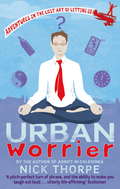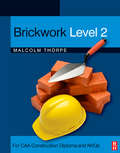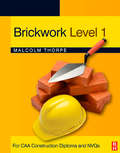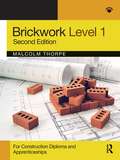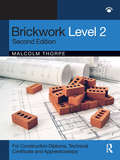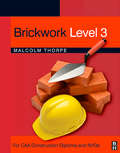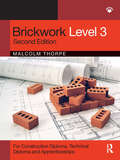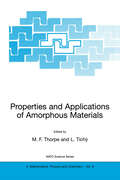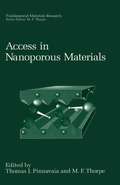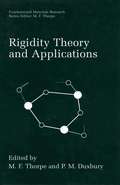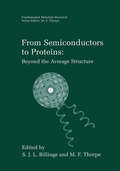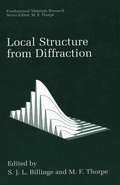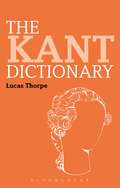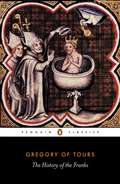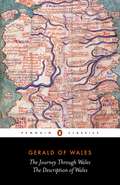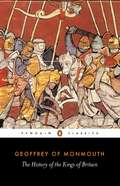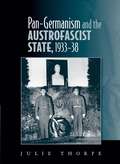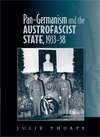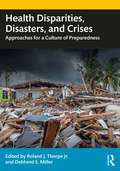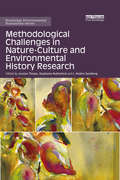- Table View
- List View
Urban Worrier: Adventures in the Lost Art of Letting Go
by Nick ThorpeHunched exhausted at his computer one ordinary Monday morning, world-class workaholic Nick Thorpe has reached the end of his tether. Fearing for his health and family life, he knows something has to change. But where to start when trying too hard is part of the problem? Nick makes a bold resolution: he will spend a year learning to let go. Beginning with a plunge off a Cornish cliff, he soon graduates to wing-walking on a bi-plane, city-centre clowning and a revealing weekend at a naturist convention. But the more he tries to relax, the bigger the questions: can you be happy if you're not in control? Is true contentment all in the mind? And what does his small, brown dog know that Nick doesn't?From a school where pupils make the rules, to meditation and rafting in Sweden; from the chaos of a Durban street shelter to a silent monastery in New Mexico, URBAN WORRIER charts a humorous and often moving quest for the ultimate modern grail: how to find balance and fulfilment in today's high-speed world.
Brickwork Level 2
by Malcolm Thorpe J. C. HodgeAs part of their everyday work bricklayers must be able to interpret technical documents, understand the properties of various mortars/building materials, and understand the basics of health and safety on site. Brickwork Level 2 has been adapted from John Hodge’s classic Brickwork for Apprentices - the established textbook on brickwork for generations of bricklayers. Now in full colour, this new book has been tailored to match Level 2 of both the Construction Alliance Awards Diplomas in Bricklaying and the Trowel Occupations NVQs. Written by Malcolm Thorpe, who acted as a CITB adviser and was involved in the draughting of the Intermediate Construction Award syllabus (bricklaying route), Brickwork Level 2 matches the latest industry-based requirements and technical developments in the field, including recent changes to the Building Regulations. This text will remain an essential reference for qualified bricklayers and other professionals working in the construction industry, as well as NVQ students wishing to embark on a career in bricklaying.
Brickwork Level 2
by Malcolm Thorpe J. C. HodgeAs part of their everyday work bricklayers must be able to interpret technical documents, understand the properties of various mortars/building materials, and understand the basics of health and safety on site. Brickwork Level 2 has been adapted from John Hodge’s classic Brickwork for Apprentices - the established textbook on brickwork for generations of bricklayers. Now in full colour, this new book has been tailored to match Level 2 of both the Construction Alliance Awards Diplomas in Bricklaying and the Trowel Occupations NVQs. Written by Malcolm Thorpe, who acted as a CITB adviser and was involved in the draughting of the Intermediate Construction Award syllabus (bricklaying route), Brickwork Level 2 matches the latest industry-based requirements and technical developments in the field, including recent changes to the Building Regulations. This text will remain an essential reference for qualified bricklayers and other professionals working in the construction industry, as well as NVQ students wishing to embark on a career in bricklaying.
Brickwork Level 1
by Malcolm ThorpeAs part of their everyday work bricklayers must be able to interpret technical documents, understand the properties of various mortars/building materials, and understand the basics of health and safety on site. Brickwork Level 1 is in full colour, and has been tailored to match Level 1 of both the Construction Alliance Awards Diplomas in Bricklaying and the Trowel Occupations NVQs. Written by Malcolm Thorpe, who acted as a CITB adviser and was involved in the draughting of the Intermediate Construction Award syllabus (bricklaying route), Brickwork Level 1 matches the latest industry-based requirements and technical developments in the field, including recent changes to the Building Regulations. This text is an essential reference for qualified bricklayers and other professionals working in the construction industry, as well as NVQ students wishing to embark on a career in bricklaying.
Brickwork Level 1
by Malcolm ThorpeAs part of their everyday work bricklayers must be able to interpret technical documents, understand the properties of various mortars/building materials, and understand the basics of health and safety on site. Brickwork Level 1 is in full colour, and has been tailored to match Level 1 of both the Construction Alliance Awards Diplomas in Bricklaying and the Trowel Occupations NVQs. Written by Malcolm Thorpe, who acted as a CITB adviser and was involved in the draughting of the Intermediate Construction Award syllabus (bricklaying route), Brickwork Level 1 matches the latest industry-based requirements and technical developments in the field, including recent changes to the Building Regulations. This text is an essential reference for qualified bricklayers and other professionals working in the construction industry, as well as NVQ students wishing to embark on a career in bricklaying.
Brickwork Level 1
by Malcolm ThorpeBrickwork Level 1 has been adapted from John Hodges’s classic Brickwork for Apprentices – the established textbook on brickwork for bricklayers. Designed to meet new requirements of the City and Guilds bricklaying programmes, this book has been written to match the latest industry-based requirements and technical developments in the field, including recent changes to the Building Regulations. Each chapter follows the syllabus and contains a section of multiple-choice questions to provide trainees with vital practice for the job knowledge and multiple-choice tests. Highly illustrated throughout and now in full colour, this is the essential reference for qualified bricklayers and other professionals working in the construction industry, as well as students wishing to embark on a career in bricklaying. There is also the facility to access the Support Material on the Routledge website that includes: PowerPoint slides for each chapter Lesson plans and schemes of work Multiple-choice questions and answers Job knowledge questions and answers Practical drawings and mark sheets
Brickwork Level 2
by Malcolm ThorpeBrickwork Level 2 has been adapted from John Hodge’s classic Brickwork for Apprentices – the established textbook on brickwork for bricklayers. Designed to meet new requirements of the City and Guilds bricklaying programmes, this book has been written to match the latest industry-based requirements and technical developments in the field, including recent changes to the Building Regulations. Each chapter follows the syllabus and contains a section of multiple-choice questions to provide trainees with vital practice for the job knowledge and multiple-choice tests. Highly illustrated throughout and now in full colour, this is the essential reference for qualified bricklayers and other professionals working in the construction industry, as well as students wishing to embark on a career in bricklaying. There is also the facility to access the Support Material on the Routledge website, which includes: PowerPoint slides for each chapter Lesson plans and schemes of work Multiple-choice questions and answers Job knowledge questions and answers Practical drawings and mark sheets
Brickwork Level 3
by Malcolm ThorpeAs part of their everyday work bricklayers must be able to interpret technical documents, understand the properties of various mortars/building materials, and understand the basics of health and safety on site. Brickwork Level 3 has been adapted from John Hodge’s classic Brickwork for Apprentices - the established textbook on brickwork for generations of bricklayers. Now in full colour, this new book has been tailored to match Level 3 of both the Construction Alliance Awards Diplomas in Bricklaying and the Trowel Occupations NVQs. Written by Malcolm Thorpe, who acted as a CITB adviser and was involved in the draughting of the Intermediate Construction Award syllabus (bricklaying route), Brickwork Level 3 matches the latest industry-based requirements and technical developments in the field, including recent changes to the Building Regulations. This text will remain an essential reference for qualified bricklayers and other professionals working in the construction industry, as well as NVQ students wishing to embark on a career in bricklaying.
Brickwork Level 3
by Malcolm ThorpeAs part of their everyday work bricklayers must be able to interpret technical documents, understand the properties of various mortars/building materials, and understand the basics of health and safety on site. Brickwork Level 3 has been adapted from John Hodge’s classic Brickwork for Apprentices - the established textbook on brickwork for generations of bricklayers. Now in full colour, this new book has been tailored to match Level 3 of both the Construction Alliance Awards Diplomas in Bricklaying and the Trowel Occupations NVQs. Written by Malcolm Thorpe, who acted as a CITB adviser and was involved in the draughting of the Intermediate Construction Award syllabus (bricklaying route), Brickwork Level 3 matches the latest industry-based requirements and technical developments in the field, including recent changes to the Building Regulations. This text will remain an essential reference for qualified bricklayers and other professionals working in the construction industry, as well as NVQ students wishing to embark on a career in bricklaying.
Brickwork Level 3
by Malcolm ThorpeBrickwork Level 3 has been adapted from John Hodge's classic Brickwork for Apprentices – the established textbook on brickwork for bricklayers. Designed to meet new requirements of the City and Guilds bricklaying programmes this book has been written to match the latest industry-based requirements and technical developments in the field, including recent changes to the Building Regulations. Each chapter follows the syllabus and contains a section of multiple-choice questions to provide trainees with vital practice for the job knowledge and multiple-choice tests. Highly illustrated throughout and now in full colour, this is the essential reference for qualified bricklayers and other professionals working in the construction industry, as well as students wishing to embark on a career in bricklaying. There is also the facility to access the Support Material on the Routledge website, which includes: PowerPoint slides for each chapter Lesson plans and schemes of work Multiple-choice questions and answers Job knowledge questions and answers Practical drawings and mark sheets
Properties and Applications of Amorphous Materials (NATO Science Series II: Mathematics, Physics and Chemistry #9)
by M. F. Thorpe L. TichýThe aim of this NATO ASI has been to present an up-to-date overview of current areas of interest in amorphous materials, with particular emphasis on electronic properties and device applications. In order to limit the material to a manageable amount, the meeting was concerned almost exclusively with semiconducting materials. This volume should be regarded as a follow-on to the NATO ASI held in Sozopol, Bulgaria in 1996 and published as "Amorphous Insulators and Semiconductors" edited by M.F. Thorpe and M.1. Mitkova (Kluwer Academic Publishers, NATO ASI series, 3 High Technology - Vol. 23). The lectures and seminars fill the gap between graduate courses and research seminars. The lecturers and seminar speakers were chosen as experts in their respective areas, and the lectures and seminars that were given are presented in this volume. During the first week of the meeting, an emphasis was placed on introductory lectures while the second week focused more on research seminars. There were two very good poster sessions that generated a lot of discussion, but these are not reproduced in this volume as the editors wanted to have only larger contributions to make the proceedings more coherent.
Access in Nanoporous Materials (Fundamental Materials Research)
by M. F. Thorpe T. J. PinnavaiaThis series of books, which is published at the rate of about one per year, addresses fundamental problems in materials science. The contents cover a broad range of topics from small clusters of atoms to engineering materials and involve chemistry, physics, and engineering, with length scales ranging from Ångstromsup to millimeters. The emphasis is on basic science rather than on applications. Each book focuses on a single area ofcurrent interest and brings together leading experts to give an up-to-date discussion of their work and the work ofothers. Each article contains enough references that the interested reader can accesstherelevant literature. Thanks aregiven to the Center forFundamental Materials Research atMichigan State University forsupportingthis series. M.F. Thorpe, Series Editor E-mail: thorpe@pa.msu.edu EastLansing,Michigan, September, 1995 PREFACE This book records selected papers given at an interdisciplinary Symposium on Access in Nanoporous Materials held in Lansing, Michigan, on June 7-9, 1995. Broad interest in the synthesis of ordered materials with pore sizes in the 1.0-10 nm range was clearly manifested in the 64 invited and contributed papers presented by workers in the formal fields of chemistry, physics, and engineering. The intent of the symposium was to bring together a small number ofleading researchers within complementary disciplines to share in the diversity of approaches to nanoporous materials synthesis and characterization.
Rigidity Theory and Applications (Fundamental Materials Research)
by M. F. Thorpe P. M. DuxburyAlthough rigidity has been studied since the time of Lagrange (1788) and Maxwell (1864), it is only in the last twenty-five years that it has begun to find applications in the basic sciences. The modern era starts with Laman (1970), who made the subject rigorous in two dimensions, followed by the development of computer algorithms that can test over a million sites in seconds and find the rigid regions, and the associated pivots, leading to many applications. This workshop was organized to bring together leading researchers studying the underlying theory, and to explore the various areas of science where applications of these ideas are being implemented.
From Semiconductors to Proteins: Beyond the Average Structure (Fundamental Materials Research)
by M. F. Thorpe S. J. L. BillingeThis series of books, which is published at the rate of about one per year, addresses fundamental problems in materials science. The contents cover a broad range of topics from small clusters of atoms to engineering materials and involve chemistry, physics, materials science, and engineering, with length scales ranging from Angstroms up to millimeters. The emphasis is on basic science rather than on applications. Each book focuses on a single area of current interest and brings together leading experts to give an up-to-date discussion of their work and the work of others. Each article contains enough references that the interested reader can access the relevant literature. Thanks are given to the Center for Fundamental Materials Research at Michigan State University for supporting this series. M.F. Thorpe, Series Editor E-mail: thorpe@pa.msu.edu East Lansing, Michigan, November 200 I v PREFACE The study of the atomic structure of crystalline materials began at the beginning of the twentieth century with the discovery by Max von Laue and by W.H. and W.L. Bragg that crystals diffract x-rays. At that time, even the existence of atoms was controversial.
Local Structure from Diffraction (Fundamental Materials Research)
by M. F. Thorpe S. J. L. BillingeThis series of books, which is published at the rate of about one per year, addresses fundamental problems in materials science. The contents cover a broad range of topics from small clusters of atoms to engineering materials and involve chemistry, physics, materials science and engineering, with length scales ranging from Ångstroms up to millimeters. The emphasis is on basic science rather than on applications. Each book focuses on a single area of current interest and brings together leading experts to give an up-to-date discussion of their work and the work of others. Each article contains enough references that the interested reader can access the relevant literature. Thanks are given to the Center for Fundamental Materials Research at Michigan State University for supporting this series. M.F. Thorpe, Series Editor E-mail: thorpe @ pa.msu.edu East Lansing, Michigan PREFACE One of the most challenging problems in the study of structure is to characterize the atomic short-range order in materials. Long-range order can be determined with a high degree of accuracy by analyzing Bragg peak positions and intensities in data from single crystals or powders. However, information about short-range order is contained in the diffuse scattering intensity. This is difficult to analyze because it is low in absolute intensity (though the integrated intensity may be significant) and widely spread in reciprocal space.
The Kant Dictionary (Bloomsbury Philosophy Dictionaries)
by Lucas ThorpeThe Kant Dictionary is a comprehensive and accessible guide to the world of Immanuel Kant, one of the most important and influential thinkers in the history of philosophy. Meticulously researched and extensively cross-referenced, this unique book covers all his major works, ideas and influences and provides a firm grounding in the central themes of Kant's thought. Students will discover a wealth of useful information, analysis and criticism. A-Z entries include clear definitions of all the key terms used in Kant's writings and detailed synopses of his key works. The Dictionary also includes entries on Kant's major philosophical influences, such as Plato, Descartes, Berkeley and Leibniz, and those he influenced and engaged with, including Fichte, Hume and Rousseau. It covers everything that is essential to a sound understanding of Kant's philosophy, offering clear and accessible explanations of often complex terminology. The Kant Dictionary is the ideal resource for anyone reading or studying Kant or Modern European Philosophy more generally.
The Kant Dictionary (Bloomsbury Philosophy Dictionaries)
by Lucas ThorpeThe Kant Dictionary is a comprehensive and accessible guide to the world of Immanuel Kant, one of the most important and influential thinkers in the history of philosophy. Meticulously researched and extensively cross-referenced, this unique book covers all his major works, ideas and influences and provides a firm grounding in the central themes of Kant's thought. Students will discover a wealth of useful information, analysis and criticism. A-Z entries include clear definitions of all the key terms used in Kant's writings and detailed synopses of his key works. The Dictionary also includes entries on Kant's major philosophical influences, such as Plato, Descartes, Berkeley and Leibniz, and those he influenced and engaged with, including Fichte, Hume and Rousseau. It covers everything that is essential to a sound understanding of Kant's philosophy, offering clear and accessible explanations of often complex terminology. The Kant Dictionary is the ideal resource for anyone reading or studying Kant or Modern European Philosophy more generally.
The History of the Franks: The Frankish Empire - Its Kingdom, Wars And Dynastic Conquest Of Early Medieval Europe (Penguin Classics Series)
by Lewis Thorpe Gregory Of ToursWritten following the collapse of Rome's secular control over western Europe, the History of Gregory (c. AD 539-594) is a fascinating exploration of the events that shaped sixth-century France. This volume contains all ten books from the work, the last seven of which provide an in-depth description of Gregory's own era, in which he played an important role as Bishop of Tours. With skill and eloquence, Gregory brings the age vividly to life, as he relates the exploits of missionaries, martyrs, kings and queens - including the quarrelling sons of Lothar I, and the ruthless Queen Fredegund, third wife of Chilperic. Portraying an age of staggering cruelty and rapid change, this is a powerful depiction of the turbulent progression of faith at a time of political and social chaos.
The Journey Through Wales and the Description of Wales
by Lewis Thorpe Betty Radice Gerald Of WalesScholar, churchman, diplomat and theologian, Gerald of Wales was one of the most fascinating figures of the Middle Ages and The Journey Through Wales describes his eventful tour of the country as a missionary in 1188. In a style reminiscent of a diary, Gerald records the day-to-day events of the mission, alongside lively accounts of local miracles, folklore and religious relics such as Saint Patrick's Horn, and eloquent descriptions of natural scenery that includes the rugged promontory of St David's and the vast snow-covered panoramas of Snowdonia. The landscape is evoked in further detail in The Description, which chronicles the everyday lives of the Welsh people with skill and affection. Witty and gently humorous throughout, these works provide a unique view into the medieval world.
The History of the Kings of Britain: An Edition And Translation Of The De Gestis Britonum (historia Regum Brittannie) (Arthurian Studies #Volume 69)
by Lewis Thorpe Geoffrey Of MonmouthCompleted in 1136, The History of the Kings of Britain traces the story of the realm from its supposed foundation by Brutus to the coming of the Saxons some two thousand years later. Vividly portraying legendary and semi-legendary figures such as Lear, Cymbeline, Merlin the magician and the most famous of all British heroes, King Arthur, it is as much myth as it is history and its veracity was questioned by other medieval writers. But Geoffrey of Monmouth's powerful evocation of illustrious men and deeds captured the imagination of subsequent generations, and his influence can be traced through the works of Malory, Shakespeare, Dryden and Tennyson.
Pan–Gemanism and the Austrofascist State, 1933–38
by Julie ThorpeThis book is about the ideas and policies that characterised the rightward trajectory of Austrofascism in the 1930s. It is the first major Anglophone study of Austrofascism in over two decades and provides a fresh perspective on the debate over whether Austria was an authoritarian or fascist state. The book is designed to introduce specialists, general scholars of fascism, and undergraduate students of interwar Austrian and Central European history, to the range of issues confronting Austrian policy and opinion makers in the years prior to the Anschluss with Nazi Germany. The book makes an original contribution to studies of interwar Austria by introducing several new case studies, including press and propaganda, minority politics, regionalism, immigration and refugees, as the issues that shaped Austria’s political culture in the 1930s. Its arguments and findings will be of value for scholars as well as students of interwar fascism and twentieth-century Austrian and Central European history.
Pan–Gemanism and the Austrofascist State, 1933–38 (PDF)
by Julie ThorpeThis book is about the ideas and policies that characterised the rightward trajectory of Austrofascism in the 1930s. It is the first major Anglophone study of Austrofascism in over two decades and provides a fresh perspective on the debate over whether Austria was an authoritarian or fascist state. The book is designed to introduce specialists, general scholars of fascism, and undergraduate students of interwar Austrian and Central European history, to the range of issues confronting Austrian policy and opinion makers in the years prior to the Anschluss with Nazi Germany. The book makes an original contribution to studies of interwar Austria by introducing several new case studies, including press and propaganda, minority politics, regionalism, immigration and refugees, as the issues that shaped Austria’s political culture in the 1930s. Its arguments and findings will be of value for scholars as well as students of interwar fascism and twentieth-century Austrian and Central European history.
Health Disparities, Disasters, and Crises: Approaches for a Culture of Preparedness
by Roland J. Thorpe Jr. DeMond S. MillerHealth Disparities, Disasters, and Crises: Approaches for a Culture of Preparedness presents a roadmap to help guide the actions needed to address health disparities introduced as part of the pre-planning, planning, and mitigation phases of natural and technological disasters. With contributions from 30 scholars in disaster management in public health, this text explores how the intersectionality of health disparities of different socioeconomic and racial/ethnic groups and how social determinants help shape exposure, and vulnerability to pandemic disasters and crises. Supported by examples from across the world, chapters are supplemented with case studies of best practices, graphs, and tables. Each of the seven parts address different topics, including how disasters affect the poor, medically underserved, and racial/ethnic groups, the impact of health disparities, and the growing link between global health, disaster planning/mitigation, and global security. Written for the benefit of undergraduate and graduate students, working professionals, and academics in the US and abroad, Health Disparities, Disasters, and Crises: Approaches for a Culture of Preparedness provides the best overall understanding of professional disaster management and safety for all citizens. It is also an ideal text for graduate and undergraduate courses in public health, public policy, medicine and nursing, healthcare administration, emergency management, emergency preparedness, homeland security, epidemiology, sociology, and medical sociology.
Methodological Challenges in Nature-Culture and Environmental History Research (Routledge Environmental Humanities)
by Jocelyn Thorpe Stephanie Rutherford L. Anders SandbergThis book examines the challenges and possibilities of conducting cultural environmental history research today. Disciplinary commitments certainly influence the questions scholars ask and the ways they seek out answers, but some methodological challenges go beyond the boundaries of any one discipline. The book examines: how to account for the fact that humans are not the only actors in history yet dominate archival records; how to attend to the non-visual senses when traditional sources offer only a two-dimensional, non-sensory version of the past; how to decolonize research in and beyond the archives; and how effectively to use sources and means of communication made available in the digital age. This book will be a valuable resource for those interested in environmental history and politics, sustainable development and historical geography.
Methodological Challenges in Nature-Culture and Environmental History Research (Routledge Environmental Humanities)
by Jocelyn Thorpe Stephanie Rutherford L. Anders SandbergThis book examines the challenges and possibilities of conducting cultural environmental history research today. Disciplinary commitments certainly influence the questions scholars ask and the ways they seek out answers, but some methodological challenges go beyond the boundaries of any one discipline. The book examines: how to account for the fact that humans are not the only actors in history yet dominate archival records; how to attend to the non-visual senses when traditional sources offer only a two-dimensional, non-sensory version of the past; how to decolonize research in and beyond the archives; and how effectively to use sources and means of communication made available in the digital age. This book will be a valuable resource for those interested in environmental history and politics, sustainable development and historical geography.
